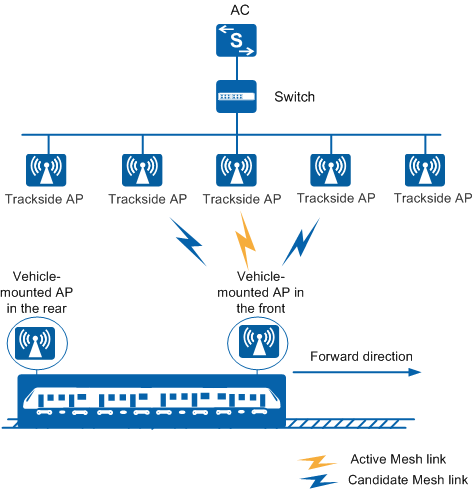Network Models of Vehicle-Ground Fast Link Handover
The vehicle-ground fast link handover network is a
single-hop Layer 2 Mesh network composed of the AC, trackside APs,
and vehicle-mounted APs.
- The AC is deployed on the ground network to manage and control trackside APs.
- Trackside APs are Fit APs deployed along the track. They function as MPPs and communicate with the AC in wired mode at Layer 2.
- Vehicle-mounted APs: are Fat APs deployed in the front and rear of a train. They function as MPs to set up Mesh links with trackside APs.
Depending on the use of vehicle-mounted APs, vehicle-ground fast
link handover has three network models:
- When a train is running, only the vehicle-mounted AP in the front works. After the train arrives at the destination, it switches the forward direction. The working vehicle-mounted AP changes accordingly.
- When a train is running, only the vehicle-mounted AP in the rear works. After the train arrives at the destination, it switches the forward direction. The working vehicle-mounted AP changes accordingly.
- When a train is running, both the vehicle-mounted APs in the front and rear work to load balance traffic. They work on different channels to communicate with trackside APs.

The network model does not affect the implementation
of vehicle-ground fast link handover. This section describes implementation
based on the first network model.
As shown in Figure 1, a vehicle-mounted AP sets up Mesh links with multiple neighboring trackside APs in the forward direction of the train and chooses the best link as the active link to transmit data. The rest of the links act as candidate links. As the train moves forward, the quality of the active link deteriorates and the vehicle-mounted AP may detect a better link. To ensure high-quality communication between the train and ground network, the vehicle-mounted AP rapidly switches to the optimal candidate link.
